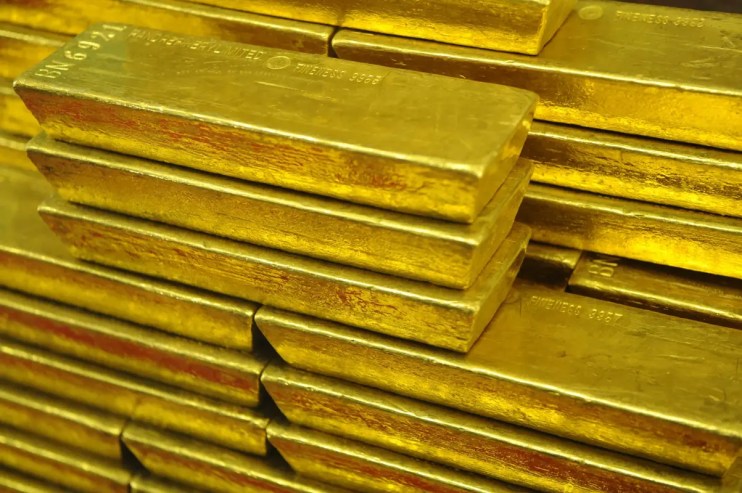Gold price: what’s behind the safe haven’s latest rally?

“Gold is money. Everything else is credit,” John Pierpont Morgan famously testified while giving evidence to a congressional subcommittee.
Investors and market watchers have long regarded precious metals as the ultimate safe haven, a place to fall back on when the world seems to be going to hell in a handcart.
This year, jitters around inflation, geopolitical unrest, and a potential US stock market bubble have all helped turn the gold chart into the shape of a hockey stick.
An ounce of the coveted soft metal is – at the time of writing – changing hands for £1,910 (/oz), up from around £1,600/oz at the start of the year and £1,484/oz in August 2023.
But what exactly is behind this major gold rally – and will it keep going?
Why is gold a safe haven?
Gold’s status as a safe haven can be traced back centuries. Used as the world’s first currency in ancient Egypt and – before that – as one of the most sought-after raw ingredients for products like jewellery and sculptures, mankind has ascribed its value for as long as it has existed.
Now, the asset is often viewed as useful protection against inflation and uncertainty. Its finite nature stands in stark contrast to cash, which can be devalued by central banks and governments as they decide to print more money.
And, unlike its inherently worthless successors—paper cash and, latterly, numbers on a screen—that rely on trust to function, its intrinsic physical value both as a store of wealth and for practical uses further inoculates it from the same collapses of which other asset classes are capable.
History also reveals it to be a particularly effective “diversification” asset – by which we mean its price does not have a close relationship to other assets, like equities or debt.
This has made it a popular vehicle led by investors, savers and pessimists alike.
Gold defies gravity:
With the inflation shocks of 2022 and 2023 now behind most major Western economies, some market commentators thought the gold price would start to mellow. Higher rates and a tighter money supply tend to make holding cash and letting it earn interest more appealing than sitting on gold, which doesn’t have a guaranteed yield.
The timing of this research is noteworthy for two reasons. It was published in January, long enough ago to be at the height of rate cut speculation across Western developed economies when markets were pricing in as many as five rate cuts. Yet it was also recent enough for the inflationary events of October 7 – and the subsequent fighting in Gaza and the Red Sea shipping crisis – to have both taken place continued afoot long enough for them not to be viewed as short-term shocks.
JP Morgan factored both of these major drivers into their gold forecast, and still, the gold price had shot past their estimate before the end of April 2024. Why?
What’s behind the spiralling gold price?
As ever, there is no catch-all reason to explain the rise. Rather, an accumulation of factors combining to reflect growing uncertainty has pushed up the gold price.
Parochially, there are two major Western elections taking place this year. And while two British technocrats having it out this summer is unlikely to send people fleeing to their bomb shelters, the prospect of a second Donald Trump term or, worse still, a contested result that pushes the US Constitution to breaking point yet again will be playing on investors’ minds.
All the while, some of the sharpest minds in investment believe that despite this week’s temporary reprieve, inflation is here to stay. The likes of investment house Ruffer and Professor Russell Napier both anticipate rising prices to be an abiding characteristic of the next few years, thanks to de-globalisation and growth in money supply.
Gold is no different from any other asset in that its price is as much an indication of expected value as it is of current value – meaning that the current price of gold reflects predictions of a period of sticky inflation.
With these geopolitical and economic tensions rarely out of the headlines, it’s easy to ignore another major force pushing up the soft metal’s price: central banks and individuals in the global south – namely Turkey, China, India and Kazakhstan – are buying up gold in record numbers.
According to Grant’s Interest Rate Observer, the People’s Bank of China (PBOC) bought up 735 tonnes of gold in 2023, while Chinese private sector net imports totalled 1,411 tonnes in 2023 and 228 tonnes this January alone.
This latter camp’s interest in the precious metal has largely been attributed to the major collapse of the country’s housing market, prompting private investors to seek refuge in safer assets.
Meanwhile, the Chinese state’s play is – according to economist Philip Pilkington – a sign of a growing trend towards “de-dollarisation”.
In recent decades, most countries have decided to store their currency reserves in the dollar due to its consistency and robust track record.
But since the US’s seizure of Russian currency reserves in the wake of its invasion of Ukraine, nations like China and the likes of Kazakhstan have sold some of those dollar reserves to negate the damage wrought on their economies by a similar fallout with US.
